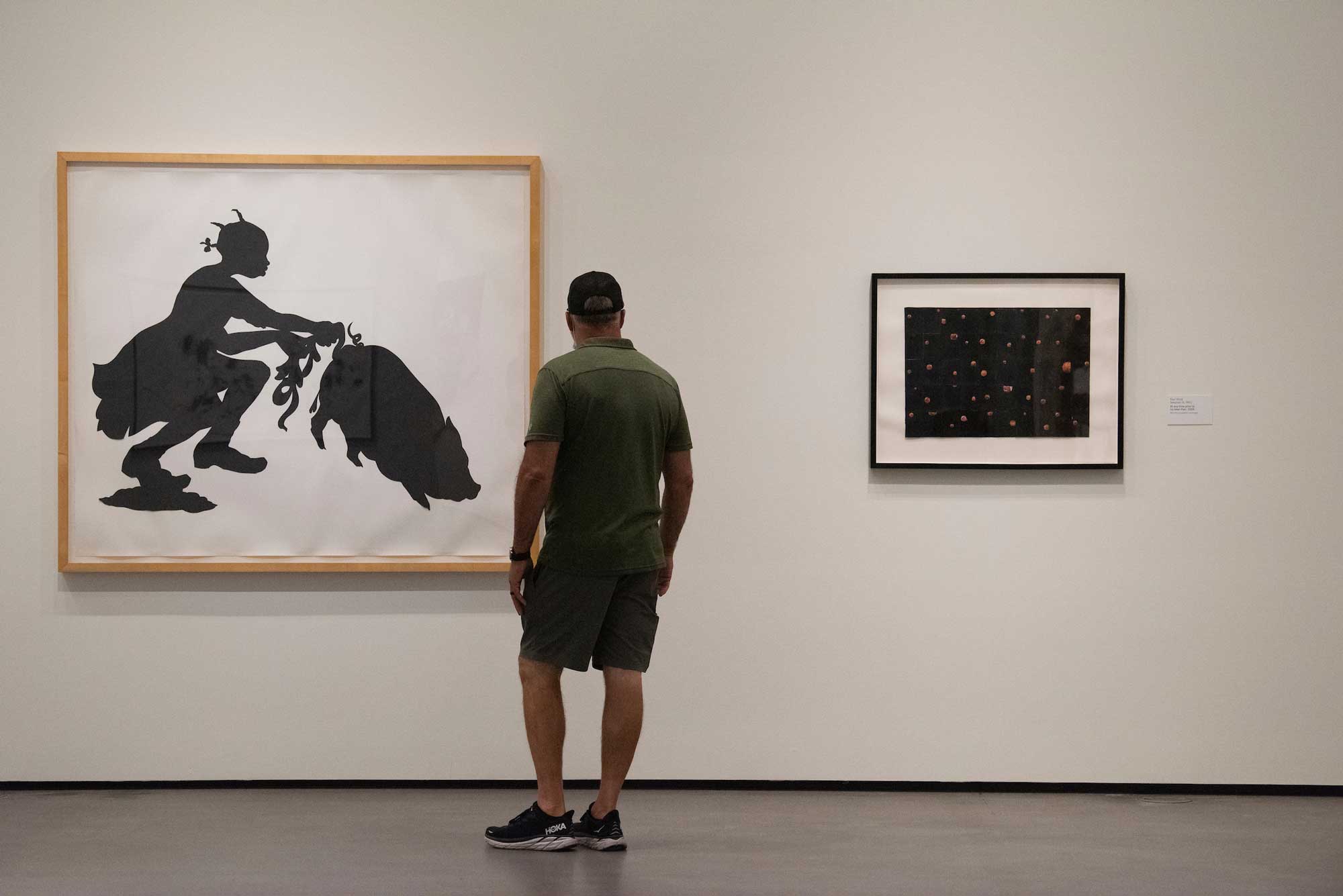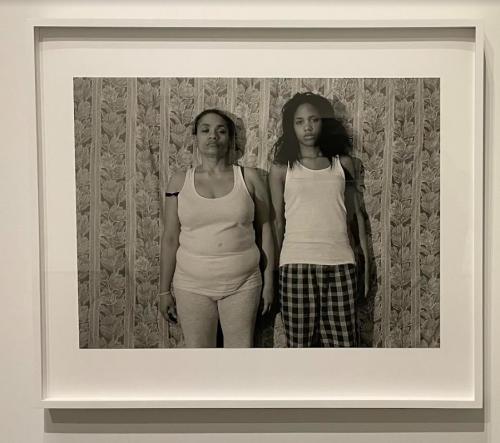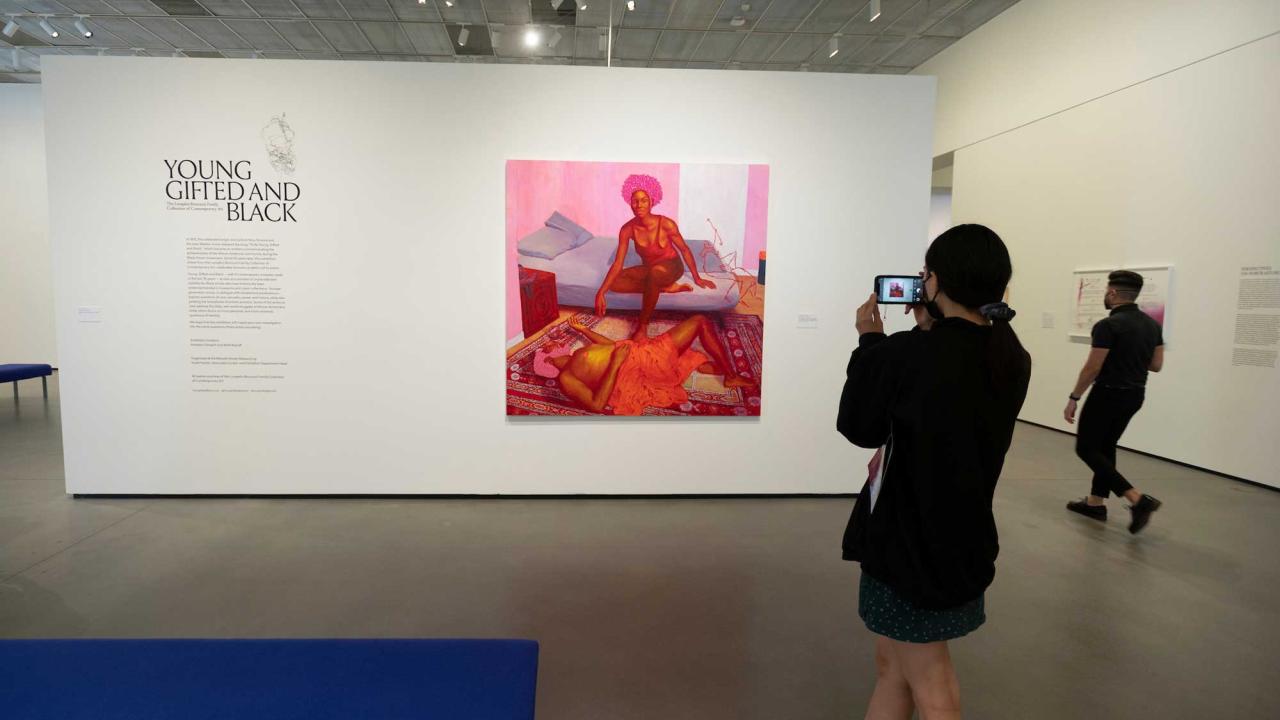Quick Summary
- Spend an entire afternoon slowly exploring each work and learning more about Black art and history
Lunchable is a feature of the UC Davis Arts Blog that recommends art exhibitions or other attractions that can be viewed during a short lunch break or other short periods of free time. The Manetti Shrem Museum is open 11 a.m.-6 p.m. Monday, Thursday and Friday, and 10 a.m.-5 p.m. Saturday and Sunday.
Celebrated singer and activist Nina Simone and the musician and poet Weldon Irvine in 1970 released the song “To Be Young, Gifted and Black,” which became an anthem commemorating the achievements of the African American community during the Black Power movement. Some 50 years later, this exhibition, drawn from the Lumpkin-Boccuzzi Family Collection of Contemporary Art, celebrates Simone’s prideful call to action.
Young, Gifted and Black — with 51 contemporary artworks made in the last 35 years — arrived this summer at the Jan Shrem and Maria Manetti Shrem Museum of Art at a moment of unprecedented visibility for Black artists who have historically been underrepresented in museums and major collections. (Catch it now through December.) Now you can view these works and learn more about Black art and visibility during your lunch break or other short break or even a weekend day. You can spend an entire afternoon slowly exploring each work and learning more about Black art and history through detailed descriptions printed on the walls as you tour the exhibit.
Younger-generation voices, in dialogue with established predecessors, explore questions of race, sexuality, power and history, while also pushing the boundaries of artistic practice. Some of the works on view address the daily, real-world struggles of artists of African descent, while others focus on more personal, and more universal, questions of identity.
The Nights I Don’t Remember, the Nights I Can’t Forget
When you enter the museum, you’ll be met face to face with an introduction to the exhibit alongside Arcmanoro Niles’s The Nights I Don’t Remember, the Nights I Can’t Forget, 2018, a large canvas depicting two figures with sparkly pink Afros. The intense and shining colors of the oil, acrylic and glitter welcome visitors into the exhibition while other elements in the painting, such as the man’s position on the floor and the red outline in the background, conjure up questions and discussions about Black identity, a theme that is prominent throughout the entire collection. For me, the pink glitter popped out from the white exhibition walls, and I found it kept catching the corner of my eye as I continued around the museum, always beckoning me back and asking me to gaze upon it again.
Addressing Black identity and history through use of the color black is a focus of many artists represented in the exhibition. Contemporary visual artists such as Kerry James Marshall and Kara Walker use the visual arts to rethink and transform the way the color black and the African American experience have been historically linked. I had to step up close to Alteronce Gumby’s Gumby Nation, 2014, to discern the faded green figures from the black background. In that experience, I realized Gumby demonstrates his suggestion of color “as a shapeshifter” and its ability to demonstrate the concealment and suppression of people of color in America.
Kara Walker’s piece, a black silhouette of a little girl playing with a pig, seems innocent at first, and the bold outline catches your attention as you enter through the archway into the second room of the gallery, standing in stark contrast to the multitude of colors that fill most of the works in the first room. However, upon deeper examination it becomes shockingly clear that the girl is playing with the entrails of the pig, pointing to the complex history of slavery and racial violence. The realization, for me, left a lasting and almost uncomfortable impression, its bold outlines hard to forget as I continued around the exhibition.

While some of the artists focus on reclaiming the color black as a representation of the African diasporic experience, others, particularly the emerging generation of painters, explore the human form through a riotous and radical explosion of color.

Taken together, these sensationally colored works invoke surrealist and psychedelic visual histories to tackle issues of race and identity. In doing so, they represent a massive reworking of visual histories that update 20th century responses to rapid social change, shifts in moral and ethical boundaries, and expanding notions of identity. Cy Gavin’s paintings call to mind the psychedelic in his use of color.
See work of visiting artist Jennifer Packer
One also catches fresh approaches to nature and the landscape in the paintings of Christina Quarles, Caitlin Cherry, Tunji Adeniyi-Jones and Jennifer Packer. Packer, who was an artist in residence at the California Studio at UC Davis during the Winter 2022 quarter, creates expressionistic portraits, interior scenes and still lifes that suggest casual intimacy through their vigorous, loose brushwork and soft color palette.
Her art sometimes reflects on instances of institutional violence toward African Americans. Blessed Are Those Who Mourn (Breonna! Breonna!) refers to the police killing of Breonna Taylor in her apartment in 2020. It is not a painting of Taylor, but of a man lying on a couch. Say Her Name, from 2017, commemorates the life of Sandra Bland, who died in police custody after being arrested during a traffic stop. The painting is a floral still life, which is another type of work Packer does frequently.
In Packer’s featured piece in Young, Gifted and Black left Untitled, 2011-13, the artist leaves her figure's eyes and face partially obscured. Passing by the artwork in person, it is the figure’s torso, made of a watercolor texture inky blacks, midnight blues, and desert yellows that caused me to slow and stop to take a closer look.
In the description of the work, Packer says:
“I think about images that resist, that attempt to retain their secrets or maintain their composure, that put you to work.”
A sense of secrecy is certainly evident as you closely examine the mottled edges of the figure’s sleeves, the texture drawing attention to itself while also avoiding distinct features to maintain a metaphorical distance. You’ll find yourself staring at the painting for a long moment, dissecting each brushstroke in an attempt to know Packer’s subject better.Some of the artists in this exhibition explore identity through the physical making of their work, using nontraditional materials to challenge mainstream ideas of what makes a material meaningful.

These investigations begin with the idea of the canvas itself: Eric N. Mack’s Pain After Heat, 2014 uses a packing blanket, and Chiffon Thomas’ A mother who had no mother (2018) is supported by a window screen. The window screen and packing blanket evoke memories of home as a place of both comfort and instability.
Sravya Dandamudi, a senior majoring in Environmental Policy Analysis and Planning and touring the museum on a recent Saturday afternoon, said of her overall experience, “I’ve learned some political history that I had never heard of in a classroom setting. However, I think the most significant part of this exhibit was seeing Black and queer artists spotlighted which I’ve never really had the chance to experience.”
The highlighting of Black and queer artists is no clearer than in LaToya Ruby Frazier’s black-and-white photograph, Momme Portrait Series (Floral Comforter), 2008, one in a series of collaborations between Frazier and her mother. The title, a conjunction of “mom” and “me,” references both the collaborative nature of the project and the conjoined appearance of those sitting between two generations of women facing the challenges of life in Rust Belt communities. But it’s not just the history of the photograph that is important. Frazier depicts herself and her mother for visitors of the exhibit. Both women look at the camera, appearing to stare right at visitors walking by. Dressed in just their pajamas, both women make themselves seen.
Visit this collection yourself and appreciate the work of Black artists and Black culture at the Jan Shrem and Maria Manetti Shrem Museum of Art. The museum is free for all and is open 11 a.m.-6 p.m. Monday, Thursday and Friday, and 10 a.m. -5 p.m. Saturday and Sunday.
